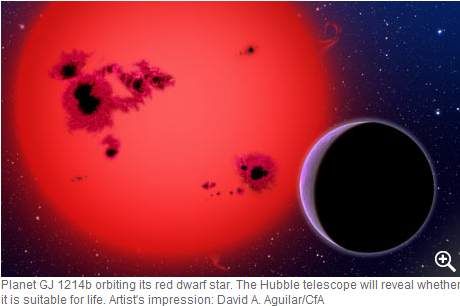The science journal Nature reported in a study published Wednesday that a new Earth-like planet that is larger than Earth and appearing to be more than half covered with water, and possibly with conditions allowing the existence of life, has been discovered by graduate student Zachory Berta, a co-author on the paper submitted to Nature with David Charbonneau who heads the Harvard-Smithsonian Centre for Astrophysics.
 The UK’s Guardian has the story today:
The UK’s Guardian has the story today:
A giant waterworld that is wet to its core has been spotted in orbit around a dim but not too distant star, improving the odds that habitable planets may exist in our cosmic neighbourhood.
The planet is nearly three times as large as Earth and made almost entirely of water, forming a global ocean more than 15,000km deep.
Astronomers detected the alien world as it passed in front of its sun, a red dwarf star 40 light years away in a constellation called Ophiuchus, after the Greek for “snake holder”.
The discovery, made with a network of amateur telescopes, is being hailed as a major step forward in the search for planets beyond our solar system that are hospitable to life as we know it.
[snip][
The latest planet is only a stone’s throw away in astronomical terms, meaning scientists will be able to turn the Hubble Space Telescope towards it and analyse its atmosphere, potentially revealing signs of life. Charbonneau’s team has already requested time on the space telescope.
“Using the Hubble, we can look at the atmosphere and say not only whether it’s habitable, but whether it’s inhabited,” Charbonneau told the Guardian. “If we find oxygen in the atmosphere things will get really interesting, because on Earth all the oxygen in the atmosphere comes from life.”
The Nature paper is only accessible to Nature subscribers, but the abstract is publicly accessible:
